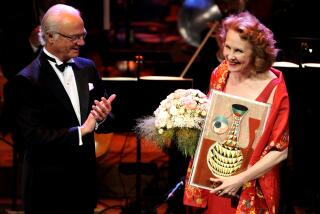Hiroshi Teshigahara; Broadened Japan’s Cinema
- Share via
TOKYO — Japanese director Hiroshi Teshigahara, best known overseas for his groundbreaking film “Women in the Dunes” and as the first Asian director nominated for an Academy Award, died Saturday of leukemia at a Tokyo hospital. He was 74.
The 1964 release of “Woman in the Dunes,” which drew on the surrealist films of Luis Bunuel and his own ideas about existentialism, earned Teshigahara worldwide acclaim. In addition to the Oscar nomination, he won the Special Jury Award at Cannes for the film.
Teshigahara’s films often focused on the struggle between the individual and society, whether it was consumerism in “Woman in the Dunes,” social bonds in 1966’s “The Face of Another” or the U.S. military and Japanese police in 1972’s “Summer Soldiers.”
Teshigahara’s genius was his ability to move classic forms beyond their traditional bounds in ways that sparked tension and strain. He once said creation reaches near-perfection just before destruction.
Along the way, he helped introduce traditional Japanese culture to a wide audience at home and abroad: The director was also accomplished in ceramics, calligraphy, stagecraft and flower arranging.
“It’s my desire to find a liberation from the confinement of the traditional Japanese art world, with its narrow, rigid ideas, and create things that belong to the whole world,” he once said. “If you wish to create something new, first go back to the roots from which the creative dynamic flows and then choose your own path.”
Teshigahara was born in Tokyo into a family deeply rooted in Japanese culture. His father founded the Sogetsu School of Ikebana, one of Japan’s most famous schools of flower arranging, and the house during his childhood was filled with students, artists and intellectuals.
His traditional grounding, reinforced by formal training in the tea ceremony and fine arts, provided a base that he would embrace, manipulate and rebel against throughout his career.
“To remember Hiroshi is to remember his talent, generosity, openness and above all his enthusiasm,” said author and film critic Donald Richie.
Teshigahara graduated from the Tokyo University School of Fine Arts and Music in 1950 with a degree in oil painting and made his first film in 1953, a documentary about the woodblock artist Hokusai.
Five years later, he formed the Sogetsu Art Center, a magnet for avant-garde artists, before making his second film in 1959, called “Jose Torres,” a documentary about a New York boxer.
Away from the camera, Teshigahara explored other art forms, elements of which he would then bring back to his films. He founded a ceramics center in 1973 and followed his father to become master of the Sogetsu school in 1980.
His pottery often took on tortured, distorted shapes. And his internationally acclaimed bamboo exhibits--including one used in a French production the Puccini opera “Turandot”--featured strands shooting skyward and falling back in various wild droopy forms, a sharp break with conventional ikebana.
Japanese film critic Kyushiro Kusakabe said that while other great Japanese directors such as Akira Kurosawa worked hard to attain success, Teshigahara’s natural gift and cultural depth made his path seem almost effortless.
“He has given Japan and the world a great deal,” Kusakabe said. “He led the world in integrating flower arrangement, film, ceramics and the stage.”
Teshigahara is survived by his wife, Toshiko Koyayashi, and two adult daughters, Kiri and Akane.
*
Times staff writer Makiko Inoue in Tokyo contributed to this story.
More to Read
Only good movies
Get the Indie Focus newsletter, Mark Olsen's weekly guide to the world of cinema.
You may occasionally receive promotional content from the Los Angeles Times.






